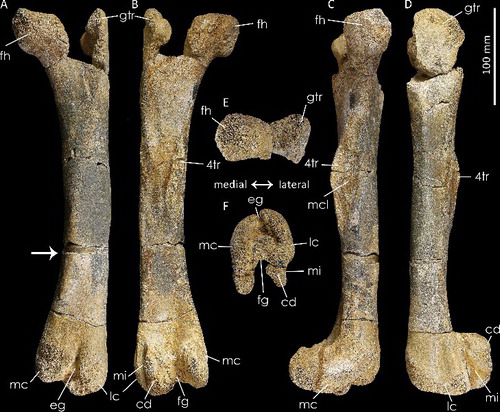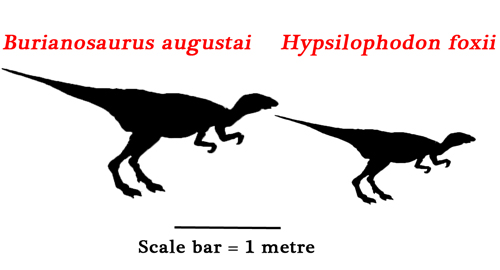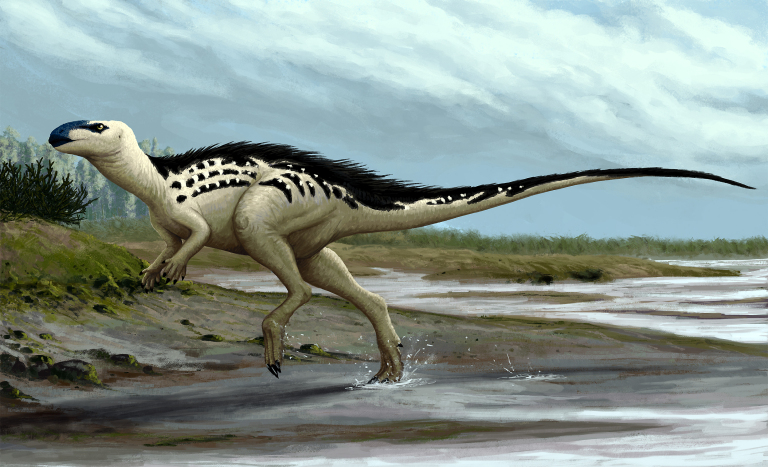New Basal European Ornithopod Described
Burianosaurus augustai – Unappreciated Ornithopods
A new basal ornithopod has been named in honour of Zdeněk Burian. The dinosaur has ben named Burianosaurus augustai.
If you were able to book yourself onto a time-travelling safari to the Cretaceous, before journeying into the long distant past, you might explain to the travel guide that you would be hoping to spot a tyrannosaur, get up close to a browsing armoured dinosaur or possibly take some photos of Triceratops. However, we suspect, that even if such a venture was possible, few tourists would spare a thought for one group of dinosaurs, that ironically, you would be much more likely to encounter. These are the ornithopods, that diverse and extremely successful group of bird-hipped dinosaurs, that are often overlooked.
A new basal ornithopod has been named and described this week – Burianosaurus augustai. A plant-eating dinosaur named after the palaeoartist Zdeněk Burian, who, in his lifetime did much to raise the profile of the Dinosauria.
An Illustration of Burianosaurus (B. augustai)
Picture credit: Edyta Felcyn
The Dinosaur Equivalent of Antelopes
They lacked horns, body armour and for the majority, they did not reach huge sizes, but these herbivores would have made up a significant component of the dinosaur fauna in most Cretaceous ecosystems. If you were to go on a safari to the Maasai Mara of Kenya or the Serengeti of Tanzania, tourists might be keen to spot lions, leopards and elephants but in all likelihood, you would encounter a great many different types of antelope. Dinosaurs like the newly described Burianosaurus can be considered as being the dinosaur equivalent of today’s antelopes.
Described from a single, well-preserved, left femur (thigh bone), Burianosaurus is the first dinosaur to be named from fossils found in the Czech Republic. It is not the first dinosaur fossil from the Czech Republic to be scientifically described, that honour goes to a single, broken tooth from an indeterminate theropod from Upper Jurassic sediments that was described in 2014, coincidentally by the lead author of the paper describing Burianosaurus, Daniel Madzia (Polish Academy of Sciences).
The Fossilised Thigh Bone of Burianosaurus (Various Views)

Views of the left femur, the only fossil from which the basal Ornithopod Burianosaurus augustai has been described.
Picture credit: The Journal of Systematic Palaeontology
The photograph (above), shows various views of the left femur of Burianosaurus. This is the holotype fossil (NMP Ob 203), from which this genus was described.
Described from a Single Fossil Bone
It is not common these days, to have a new dinosaur genus erected on the description of a single bone. When this fossil was first studied back in 2005, it was assigned to the iguanodontids. However, over recent years the Iguanodontia and their relatives have been subject to phylogenetic reassessment and many of the taxonomic relationships between different components of the Ornithopoda have been revised. The single bone was preserved in such fantastic condition, that its shape and muscle scars proved crucial in assigning a new dinosaur genus.
The views of the femur are (A) a view from the front, (B) viewed from the back, (C) a medial view (the bone viewed from the side closest to the body, think of it as the “inside leg view”) and (D) a lateral view, the bone viewed from the side of the bone towards the outside of the body. Photographs (E) and (F) are views of the bone from the top looking down (proximal) and from the bottom of the bone looking up (distal).
The scale bar is 10 centimetres and the white arrow in (A) indicates the site from which a small sample of fossil bone was taken to permit an internal examination of bone structure to take place. This histology helped the research team, writing in the Journal of Systematic Palaeontology, to identify this specimen as coming from a young, adult animal.
Burianosaurus augusta was Bigger than Hypsilophodon (H. foxii)
A lot of work has recently been undertaken in a bid to better understand how different ornithopods were related to each other. These dinosaurs are characterised by their small, quite triangular heads, large orbits (eye sockets) and relatively primitive dentition (at least when compared to their relatives that comprise the Ankylopollexia clade – more derived iguanodonts, camptosaurs and the duck-billed dinosaurs). Their front limbs tended to be much shorter than their hind limbs, so these dinosaurs were probably bipedal, although capable of dropping onto all fours if needed.
Burianosaurus has been depicted as being very similar to Hypsilophodon (H. foxii), to which it was related. However, the largest H. foxii thigh bone that we at Everything Dinosaur are aware of, is only about half the size of the holotype of B. augustai. Based on this we estimate that Burianosaurus was around four metres long.
Size Estimate Burianosaurus Compared to Hypsilophodon

An approximate size comparison between Burianosaurus and Hypsilophodon (H. foxii). Picture credit: Everything Dinosaur.
Picture credit: Everything Dinosaur
Honouring Burian and Augusta
The genus name honours the famous palaeoartist Zdeněk Burian (1905–1981), whilst the species name refers to the influential palaeontologist and author Josef Augusta (1903 – 1968), who between them, did much to popularise the study of prehistoric animals. Like Burianosaurus, both Burian and Professor Augusta came from the Czech Republic.
The single fossil bone that represents this new genus (the thigh bone), was found in the Korycany Beds of the Peruc-Korycany Formation. These are a series of marine deposits laid down in a shallow sea, close to land during the Cenomanian faunal stage of the Late Cretaceous. Team members at Everything Dinosaur estimate that Burianosaurus lived around 95 million years ago.
For models and replicas of ornithopods like Burianosaurus augusta: CollectA Age of Dinosaurs Popular Range.
Burianosaurus augusta
In the scientific paper, the researchers carry out a series of phylogenetic analyses of ornithopod data and as a result, B. augustai is classified as a basal ornithopod, however, quite how the Ornithopoda is configured remains open to debate. If you do ever get the chance to participate in a time-travelling safari to the Cretaceous, look out for these fast-running, bipeds, fossils of which are just as valuable to science as that of any other dinosaur.
The scientific paper: “A Basal Ornithopod Dinosaur from the Cenomanian of the Czech Republic” by Daniel Madzia, Clint A. Boyd and Martin Mazuch published in the Journal of Systematic Palaeontology.
Visit the Everything Dinosaur website: Everything Dinosaur.


